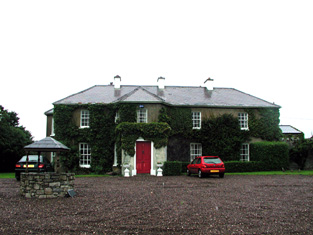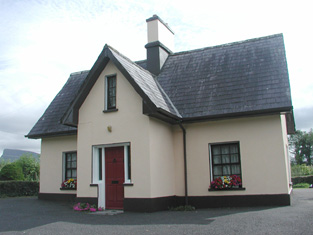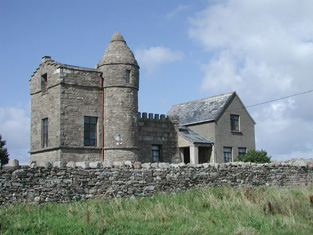Rindaly Cottage
Houses within 15km of this house
Displaying 36 houses.
Houses within 15km of Rindaly Cottage
Displaying 36 houses.
| House name | Description | |
|---|---|---|
| Lissadell or Lissadill | The Gore Booth family built the first Lissadell House between 1750-1760, in front of the current house. The current house was built in the late eighteenth and early nineteenth century and continued to be the home of the Gore Booth family until the 1990s. In 1906 the house and buildings were valued at £347. The house has been open to the public for many years. It is now owned by E. Walsh and C. Cassidy and is being restored. See www.lissadellhouse.com. |

|
| Streedagh | It is likely that Thomas Jones built a house at Streedagh c 1725. However, the present house dates from the early years of the nineteenth century. In 1906 it was the property of Richard W. Jones and was valued at £18. It is still extant and occupied. |

|
| Moneygold | At the time of Griffith's Valuation, Moneygold was leased by the Fawcett family from Viscount Palmerston's estate and was valued at £13. Lewis records it as the residence of the Soden family in 1837. McTernan notes that it was the seat of the family from the early eighteenth century when James Soden leased almost 1000 acres from the Temple estate. In 1906 it was the property of Major G.M. Eccles whose mother was Isabella Soden. The house was damaged in a storm in the early 1960s and subsequently demolished. | |
| Mount Temple | Viscount Palmerston was leasing a property valued at £3 15s to Edward Parke in this townland at the time of Griffith's Valuation. It is estimated that the house now at Mount Temple was built c.1860. McTernan notes that the property was originally part of the Soden estate but was leased to the Parkes in the 1830s. They were to continue in occupation until the 1940s after which Mount Temple was acquired by the Land Commission. The house is still extant but derelict. |

|
| Classiebawn Castle | Classibawn was built for Lord Palmerstown in 1874. It afterwards passed to the Ashley family and is still in the possession of their descendents. In 1906 it was valued at £69. |

|
| Glenade | Glenade was built c.1833 as a residence for Cairncross Cullen and is still extant. At the time of Griffith's Valuation it was valued at £30. Since 2005 it has been offered for sale. Glenade House was the residence of Loftus Tottenham during the Famine. The family also owned Cornwall House in Bundoran. In 1906 Thomas Corscadden owned 100 acres of untenanted land and a mansion house valued at £14 in the townland of Gubinea . |

|
| Kinlough House (Oakfield House) | Kinlough House was originally known as Oakfield House and was the seat of the Johnston family from the early eighteenth century. It was remodelled in the 1820s by Robert Johnston and renamed Kinlough House. At the time of Griffith's Valuation, Kinlough House was occupied by William Johnston and was valued at £45. In 1906 James Johnston was the owner of the mansion house at Kinlough valued at £43 as well as 220 acres of untenanted demesne land. In 1943 the Irish Tourist Association Survey recorded that the house had been destroyed by fire some 20 years previously but that the gardens were still open to the public. Kinlough House is depicted in a ruined state in the Buildings of Ireland survey. Major new housing development is occuring on the site, adjacent to the walled garden. |

|
| Brookhill (Rossinver) | Brookhill is described as the residence of Capt. Johnston in 1835. At the time of Griffith's Valuation, it was occupied by Johnston Sharpe and valued at £10. In 1894 Slater notes that it was the seat of Capt. Forbes Johnston. It is the only Johnston residence still extant. |

|
| Tynte Lodge | Joseph Tynte was leasing lands from the White estate and later purchased 30 acres of land from Lord Massy (who had inherited that estate) for the building of Tynte Lodge. The Inventory of Architectual Heritage, however, contends that Tynte Lodge was built in the eighteenth century so perhaps Tynte was reconstructing an earlier building. At the time of Griffith's Valuation the property at Tullaghan was valued at £18 and was leased by Tynte to Hugh Montgomery. In 1906 Mervyn Tynte was the owner of the mansion house at Tullaghan valued at £51. |

|
| Ward House | At the time of Griffith's Valuation this property was held in fee by James Ellis when the house was valued at £10. It is labelled Ward House on both the 1st and 25-inch edition Ordnance Survey maps. The original house is no longer extant. | |
| Mount Prospect | At the time of Griffith's Valuation, William Johnston was leasing a house valued at £14 to Glasgon Connolly at Aghaderrard West, barony of Rosclogher. This is the house known as Mount Prospect. Both the Ordnance Survey Field Name Books and Lewis record Mount Prospect as a seat of the Connolly family in 1837. In 1894 and 1906 it was the property of St. George Robert Johnston and was also valued at £14. The remains of various buildings still exist although a new house seems to have been constructed at the site near the lake shore. |

|
| Woodville | Described in 1835 as formerly having good offices and a well-managed garden but had a deserted looking appearance at that time. The Irish Tourist Association survey in 1943 recorded that the ruins of Woodville House were located in the townland of Tawly. The house was demolished around 1908 when the estate was divided. | |
| Duncarbry Lodge | At the time of Griffith's Valuation John R. Dickson was the owner of two properties at Duncarbry, barony of Rossinver, one valued at £18 and the other at £10. Lewis records that Rev. Dickson was residing at Duncarbry Lodge in 1837. |

|
| Lareen | Lareen House was built in the 1820s by Luke White who died in 1854 and is buried in the old cemetery in Kinlough, the only member of the White family to be buried in the locality. Lareen then passed to the Massy family of county Limerick (Baron Massy of Duntrileague). In 1906 it, together with about 1200 acres of untenanted land in the area, was the property of Lord Massy. The house was valued at £23 at the time. Lareen was sold in the early 20th century to Maxwell Blacker Douglass who also bought fishing rights on both banks of the Drowes river and Bundrowes House. Lareen House burnt down in 1933. The Irish Tourist Association survey of 1943 mentions that it was in a ruined condition due to this fire. | |
| Tullaghan House | At the time of Griffith's Valuation Tullaghan House was in the possession of Joseph P. Tynte who was leasing it from Col.White's estate. Subsequently it became a residence of the Dickson family. It is still extant. |

|
| Clogh | In 1906 Sir Jocelyn Gore Booth was the owner of buildings valued at £70 at Clogh, barony of Carbury. There are no building of similar valuation at the time of Griffith's Valuation. | |
| Finned House | In 1906 Sir Jocelyn Gore Booth owned buildings valued at £8 at Finned, barony of Carbury. This is likely to be Finned House. This townland was the property of the Gore Booth estate at the time of Griffith's Valuation but the highest building valuation at that time was only £2. | |
| Ballygilgan Gate Lodge | In 1906 Sir Jocelyn Gore Booth held over 800 acres of untenanted land at Ballygilgan as well as a house valued at almost £9. |

|
| Kilkilloge Tower | In 1906 the Ashley estate owned a property at Killkiloge, barony of Carbury, valued at £16. This may be the extant building which was modelled on a medieval look out tower. |

|
| Wynnesfort House | In 1906 Alexander Lyons owned a property valued at £8 at Rahaberna, barony of Carbury. At the time of Griffith's Valuation this property was leased from the Lyons estate by George Robinson. McTernan states that the lands passed from the Knox to the Wynne estate in the late eighteenth century. In the early nineteenth century William C. Wood of Rathellen had possession and the house was let to a succession of tenants. It was sold in the Encumbered Estates court in 1853 when the purchaser was Henry Lyons. | |
| Castlegal House | At the time of Griffith's Valuation George Dunne was leasing two properties in the townland of Castlegal to the Parke family. John Parke was renting a house valued at £7 together with 50 acres while Phillip Parke was leasing a house valued at £5 and 98 acres. McTernan states that prior to being owned by the Dunn family this property belonged to the Cope estate. Castelgal is still extant and occupied. | |
| Rahelly | Francis Barber was leasing a house at Rahelly, barony of Carbury, from the Gore Booth estate at the time of Griffith's Valuation, when it was valued at £25. Rahelly later fell into ruin but has been restored and offered for sale in recent times. |

|
| Mount Edward Cottage | Both the Ordnance Survey Field Name Books and Griffith's Valuation record a property at Mount Edward as belonging to Capt. James Jones. It had a valuation of £2 in the 1850s. This would appear to be the property named as Mount Edward Cottage on the 1st edition OS map. McTernan states that it was occupied by the Hood family from the mid-nineteenth century until the 1980s. It is now in a dilapidated state. | |
| Glenade House [Largydonnell] | The building at this site is labelled Largydonnell on the First Edition Ordnance Survey map. On the later 25-inch edition, Glenade House is noted. Loftus Tottenham was the owner of a property valued at £20 at Largydonnell, parish of Rossinver at the time of Griffith's Valuation. The sale in 1878 included this property. In 1894 Slater recorded it as the seat of George Loftus Tottenham. It is no longer extant. | |
| Hollyfield House | At the time of Griffith's Valuation, Patrick Dwyer was leasing the townland of Edencullentagh or Hollyfield from the Gore Booth estate. This included Hollyfield House, then valued at £6. McTernan indicates that Dwyer was employed as a land steward by the estate. The house had a successionof owners thereafter and was in a derelict condition by the end of the twentieth century but has since been restored. |

|
| Oxfield | At the time of Griffith's Valuation, Oxfield House was the caretaker's residence for the plantation of over 150 acres owned by the Gore Booth estate at Cullaghmore, barony of Carbury. | |
| Springfield | The Phibbs estate owned several houses as well as the townland of Springfield or Magheralgillerneeve, barony of Carbury at the time of Griffith's Valuation. One house, valued at £12, was being leased by John Mullan. | |
| Tully House (Carbury) | Charles Simpson was leasing a house valued at £6 at Tully, barony of Carbury, from the Wynne estate, at the time of Griffith's Valuation. A house is still extant at the site. | |
| Drumcliff | The townland of Drumcliff South formed part of the Gethin estate in this area in the eighteenth century. This house was leased to Charles Allen at the time of Griffith's Valuation, when it was valued at £12 10s. The house had a succession of owners in the twentieth century and is still extant and occupied. | |
| Moorfield Cottage | Jeremiah Rogers, a steward on the Gore-Booth estate, was occupying this property at the time of Griffith's Valuation, when it was valued at £5 10s. McTernan states that it remained in the Rogers family until the early decades of the twentieth century. It is still extant and occupied. | |
| Urlar or Beckfield | Leased by William Hamilton,MD, from the Gore-Booth estate at the time of Griffith's Valuaiton when it was valued at over £10. McTernan notes that it was previously held by the Munns family and later in the nineteenth century by George Somerville. Labeled as Beckfield on the First Edition Ordnance Survey Map. It is still extant and undergoing restoration. | |
| Fair View (Dane Ville) | The property at this site is labelled as Fair View on the 1st edition Ordnance Survey map of the late 1830s. On the 25-inch edition of the early 20th century it is labelled Dane Ville Lodge. At the time of Griffith’s Valuation, it was being leased by Mrs. Deane from the representatives of Colonel Dickson and Thomas Conolly’s estate when it was valued at £18. The site is now occupied by a modern house. | |
| Rockfort Lodge | Charles Rochfort was occupying this property at the time of Griffith’s Valuation, leasing from the Dickson estate. It was then valued at £20. The house is still extant but does not appear to be in good repair. | |
| Fair View, later Dane Ville | The property at this site is labelled as Fair View on the 1st edition Ordnance Survey map of the late 1830s. On the 25-inch edition of the early 20th century it is labelled Dane Ville Lodge. At the time of Griffith’s Valuation, it was being leased by Mrs. Deane from the representatives of Colonel Dickson and Thomas Conolly’s estate when it was valued at £18. The site is now occupied by a modern house. | |
| Mahgeracar | At the time of Griffith’s Valuation, in the 1850s, Thomas Ellis was leasing property in Magheracar townland from the Conolly estate. The building was valued at £15 15s. Ellis, in turn, was leasing a property to William Forde, valued at over £10. | |
| Rose Lodge or Dingleicoush | Penelope St. George was leasing this property from the Conolly estate at the time of Griffith’s Valuation, when it was valued at £17. The house is no longer extant. On some earlier maps it is labelled as Rose Lodge but on the 25-inch map of the early 20th century it is labelled Dingleicoush. |

